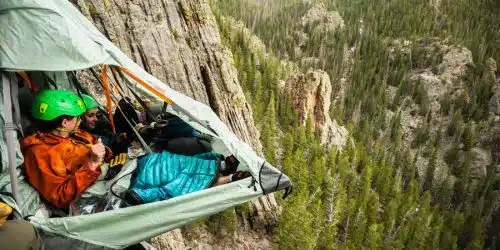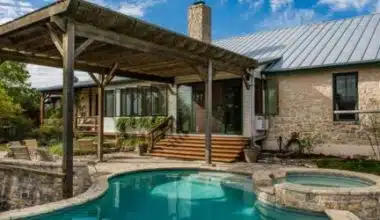A new trend in adventure tourism has evolved that elevates camping to incredible heights—literally. Cliff camping, also known as high cliff camping or sea cliff camping, provides adrenaline junkies with a one-of-a-kind and exhilarating experience by allowing them to set up camp on the edge of towering cliffs. This adventurous style of outdoor lodging has grown in appeal among thrill-seekers who crave breathtaking views and an unrivaled sense of adventure. However, as with any extreme activity, safety precautions must be taken to ensure a memorable and safe experience. In this blog article, we will delve into the world of cliff camping, exploring its attractiveness, potential deaths, safety measures, and the precautions necessary to enjoy this magnificent adventure properly.
Cliff Camping Deaths
Cliff camping provides an unforgettable experience that immerses adventurers in breathtaking natural surroundings. Consider yourself perched on a ledge, high above the ground, with nothing but the great horizon ahead of you. The stunning scenery, the serenity of being suspended in nature, and the sensation of accomplishment are all part of what draws adrenaline junkies to cliff camping.
Cliff camping has a distinct attraction that appeals to both adventure seekers and nature lovers. Visitors come from all over the world because of the unparalleled experience that comes with being on a cliff’s edge and surrounded by breathtaking views.
#1. Unrivaled Scenic Beauty
The incredible scenic grandeur that unfolds before your eyes is one of the primary attractions of cliff camping. Imagine waking up to the sight of a beautiful dawn spreading golden hues across a rough beach, or watching the hypnotic ballet of waves breaking against the rocks below.
#2. Escape from the Ordinary
Cliff camping is a fantastic way to get away from the hustle and bustle of regular life. It allows people to unplug from technology, immerse themselves in nature, and enjoy a sense of solitude that is becoming increasingly rare in today’s world.
#3. Pushing Personal Boundaries
Cliff camping is a way for many adventurers to test their limits and overcome phobias. Setting up camp on the edge of a cliff necessitates a certain amount of bravery and a willingness to venture beyond one’s comfort zone. The rush of adrenaline and sense of accomplishment that comes with overcoming these obstacles can be life-changing.
#4. A Connection with Nature
Cliff camping allows people to form deep and intimate bonds with the natural world. The sheer proximity to nature—feeling the wind blow through your hair, hearing the quiet roar of crashing waves, or hearing the whisper of leaves in the breeze—creates an immersive experience that reawakens the senses.
The Thrill and Adventure of High Cliff Camping
Cliff camping’s charm extends beyond its visual beauty and connection to nature. The thrill and adventure of this activity distinguish it and attract daredevils and adrenaline seekers.
#1. Challenging the Norm
Cliff camping challenges conventional ideas about camping and adventure. It takes the concept of spending a night in the great outdoors to new heights. Cliff camping is a unique and dangerous experience that pushes boundaries and redefines the notion of adventure by defying gravity and venturing into perilous locations.
#2. An Adrenaline Rush like No Other
Cliff camping provides an incredible adrenaline boost. The sensation of stepping onto a small ledge or tying oneself to a hanging tent hung hundreds of feet above the ground is exhilarating. The pulse rate increases, the senses sharpen, and the excitement of being so close to the brink is indescribable.
#3. Overcoming Fear and Developing Resilience
Cliff camping necessitates confronting and conquering phobias. Fear of heights, fear of the unknown, and fear of putting oneself in a vulnerable situation are all factors. By facing these fears head-on, cliff campers gain strength, courage, and a renewed conviction in their skills. Overcoming anxiety in such an extreme setting can have a transforming effect, encouraging people to face problems in other aspects of their lives with greater confidence and drive.
#4. A Sense of Community and Camaraderie
Cliff camping frequently attracts like-minded people who share a love of adventure and a thirst for the extraordinary. The social nature of this activity generates a sense of camaraderie and connection, whether it’s engaging in guided cliff camping trips or joining a group of fellow adventurers. The pleasure of cliff camping with others is enhanced, lifelong friendships are formed, and the opportunity to exchange experiences and bond over the shared challenges and triumphs of conquering the cliffs is provided.
The Dark Side: Addressing Cliff Camping Deaths
While cliff camping is a thrilling and awe-inspiring experience, it is vital to recognize that it is not without risk. Unfortunately, there have been fatalities related to cliff camping. Understanding the negative aspects of cliff camping and addressing the factors that contribute to these deaths is critical for promoting safety and preventing future incidents.
#1. Inadequate Experience and Training
Inadequate experience and training are major contributors to cliff camping deaths. Taking part in this activity without the requisite knowledge and skills increases the likelihood of an accident occurring. Novice cliff campers may misjudge the risks, be unfamiliar with correct equipment use, or fail to detect potential hazards.
#2. Inadequate Risk Assessment and Planning
Inadequate preparation and failure to do rigorous risk assessments can result in terrible outcomes. Cliff camping necessitates a thorough examination of the chosen location, taking into account aspects such as cliff stability, anchor points, weather conditions, and hazardous fall zones. Failure to identify these hazards and plan accordingly raises the likelihood of accidents or catastrophic falls.
#3. Poor Equipment Quality and Maintenance
The use of substandard or poorly maintained equipment is a major safety hazard when cliff camping. Faulty equipment, such as worn-out ropes, faulty carabiners, or weakened anchor systems, can result in catastrophic accidents. It is critical to invest in high-quality camping gear and to inspect and maintain all equipment regularly.
#4. Unfavorable Weather Conditions
Unfavorable weather conditions can endanger cliff campers. High wind, heavy rain, thunderstorms, or fog can all produce dangerous conditions, making it difficult to maintain stability and increasing the likelihood of an accident. Ignoring or underestimating the influence of inclement weather can be fatal. It is critical to keep an eye on weather forecasts and be ready to change or cancel plans if conditions become risky.
#5. Reckless Behavior and Lapses in Judgment
Reckless action, such as leaning too far over the edge, ignoring safety precautions, or taking excessive risks, can have tragic consequences. Inadequate judgment or a disregard for personal safety can lead to tragic falls or accidents. While cliff camping, it is critical to exhibit caution, observe safety guidelines, and make sound decisions.
#6. Inadequate Emergency Preparedness
Inadequate emergency preparedness can heighten the dangers of cliff camping. Having the proper information, skills, and equipment to respond successfully in the case of an accident can make a huge difference. Cliff campers should be trained in first aid and have adequate emergency supplies on hand.
Social networking can contribute to dangerous cliff camping behaviors. Some people may prioritize producing dramatic images or videos for social media over their safety. Risky activity for social media validation might have disastrous repercussions.
Learning from Tragedies: Promoting Safety and Education
To address cliff camping deaths, the community must work together to promote safety and education. Recognizing hazards and implementing preventative steps are critical for avoiding accidents and fatalities. This includes the following:
- Promoting comprehensive training and education programs that provide aspiring cliff campers with the requisite skills, knowledge, and risk assessment abilities.
- Promoting responsible behavior by highlighting the need for comprehensive preparation, proper equipment use, and attention to safety guidelines.
- Raising awareness of the dangers of severe weather, as well as the importance of adaptability and caution in reaction to changing weather patterns.
- Encouraging frequent equipment inspection and repair, as well as advocating the use of high-quality cliff camping gear.
- Creating a culture of appropriate social media usage in which personal safety and well-being take precedence over capturing attention-grabbing content.
- Sharing and learning from true-life experiences and tragedies to emphasize the significance of safety and teach others about the dangers.
By addressing the negative aspects of cliff camping and promoting safety, the community can work together to prevent deaths, protect lives, and ensure that this incredible activity stays exhilarating and awe-inspiring for all participants.
Safety First: Addressing Concerns on High Cliff Camping
While high cliff camping is an exciting and unforgettable experience, it is crucial to prioritize safety and address issues to have a safe and pleasurable vacation. Participants can avoid dangers and fully enjoy the appeal of cliff camping with peace of mind by taking the required precautions and following appropriate procedures.
#1. Professional Counseling and Training
Seeking professional assistance and training is highly advised for newbie cliff campers. Extensive knowledge of the specific location, weather conditions, equipment usage, and safety regulations can be provided by experienced guides. They can teach vital skills such as how to build up solid anchor systems, how to use proper equipment, and how to recognize potential hazards related to cliff camping. Acquiring proper training decreases the hazards involved and improves overall safety.
#2. Site Evaluation and Preparation
It is crucial for safety to evaluate the chosen cliff camping spot thoroughly. Consider the cliff’s stability, the quality of the anchors, and the existence of loose rocks or potential fall zones. Choose well-established camping places that have been certified safe by experts or experienced climbers. Additionally, before beginning your camping experience, become acquainted with the local regulations and secure any necessary licenses.
#3. Quality and Inspected Equipment
It is critical to use high-quality, dependable gear built expressly for cliff camping. Ensure that all equipment, including tents, ropes, harnesses, carabiners, and anchors, is in good shape and is inspected regularly for signs of wear and tear. Familiarize yourself with the proper use of each piece of equipment and attentively follow the manufacturer’s instructions. Investing in high-quality equipment and replacing worn-out items is critical to sustaining safety standards.
#4. Weather Monitoring and Contingency Plans
Weather factors can have a huge impact on cliff camping safety. Keep an eye on the weather prediction for your destination and be prepared to change your plans accordingly. High winds, heavy rain, thunderstorms, and other inclement weather can make camping dangerous. Prepare a backup plan and be prepared to leave if necessary. Prioritize your safety over any desire to continue the activity in hazardous weather.
#5. Proper Anchoring and Secure Installation
High Cliff Camping requires appropriate anchoring and a sturdy camp arrangement. Choose anchor points that are robust, dependable, and capable of supporting campers’ weight and mobility. Check any anchor connections and ropes to ensure they are properly installed and tightened. Follow established techniques for securing tents and hammocks to prevent any accidental slips or falls. During your camping trip, review the setup regularly to detect and address any potential difficulties as soon as possible.
#6. Personal Safety Measures
Individual safety precautions are essential when cliff camping. While on the cliff edge or in other exposed areas, always wear a well-fitted harness and helmet. Maintain three points of contact when moving around the campsite to ensure stability. Avoid taking needless risks, such as leaning too far over the edge or acting recklessly. Be aware of your limitations and degree of comfort, and never be afraid to seek support or direction when necessary.
#7. Leave No Trace Principles
It is critical to respect the ecosystem and follow the Leave No Trace guidelines. Reduce your environmental impact by correctly disposing of waste, preventing harm to vegetation, and not leaving any traces of your presence. Keep the cliffs and associated ecosystems beautiful for future generations to enjoy.
Is cliff camping a real thing?
Yes, cliff camping is a legitimate activity that entails erecting temporary campsites on the edges of cliffs or steep rock walls. It is an adventurous type of camping that provides beautiful vistas. It often entails the use of specialized equipment, such as portable tents or hammocks, powerful anchor systems, and safety harnesses, to assure participants’ safety while sleeping or resting on the cliffside.
How does cliff camping work?
Cliff camping involves setting up a temporary campsite on the side of a cliff or steep rock face. Here’s a quick rundown of how cliff camping works:
- Location Selection
- Equipment
- Anchoring
- Safety Precautions
- Camp Setup
- Enjoy the Experience
- Safety and Vigilance
- Pack Out and Leave No Trace
Cliff camping necessitates sufficient training, expertise, and awareness of rock climbing techniques and safety standards. To ensure a safe and enjoyable experience, novice campers should seek professional instruction or training before attempting camping.
What is cliff camping called?
Setting up temporary campsites on the sides of cliffs or steep rock faces is often known as “cliff camping.” This phrase appropriately depicts the nature of the activity, in which persons sleep or relax on the cliffside using specialized equipment such as tents or hammocks.
Why do people do cliff camping?
People go cliff camping for a variety of reasons, including adventure, unique experiences, and a desire to connect with nature. Here are some of the most prevalent reasons why people opt to go cliff camping:
- Thrill and Adventure
- Breathtaking Views
- Immersion in Nature
- Escape and Solitude
- Unconventional Camping Experience
- Personal Achievement
Can you sleep on a cliff?
Yes, cliff camping is an activity that allows you to sleep on a cliff. It entails establishing a temporary encampment on the side of a cliff or steep rock face where people can sleep or rest. To secure the sleeping area to the cliff and assure safety, specialized equipment such as cliff camping tents or hammocks, ropes, and anchor systems are employed.
How do cliff climbers sleep?
Cliff climbers usually sleep in portable hanging tents or hammocks constructed expressly for use on cliffs or steep rock walls. While hanging on the cliffside, these unique sleeping systems provide a safe and pleasant sleeping environment.
Conclusion
Cliff camping is a one-of-a-kind and awe-inspiring experience for adventurers looking for an adrenaline rush and a meaningful connection with nature. However, it is crucial to proceed with caution, prioritize safety, and follow established rules when engaging in this rigorous activity. Cliff camping may be a fantastic trip that leaves lasting memories if you choose reliable operators, are well-prepared, and observe safety precautions.
Remember that the attractiveness of high-sea cliff camping should never eclipse the significance of making sound decisions and managing risks. Cliff camping may be an exceptional experience that combines the excitement of adventure with the beauty of nature if properly prepared, trained, and respected for the environment.
- BEST BEACHES IN COSTA RICA IN 2023
- Best Time to Visit Yosemite 2023: Summer, Spring, Winter & Autumn Tips
- ULTIMATE LIST OF SAN FRANCISCO AIRPORT HOTELS IN 2023
- Best Scotland Trips And Tour Packages
- WORST NEIGHBORHOODS IN CHICAGO IN 2023






